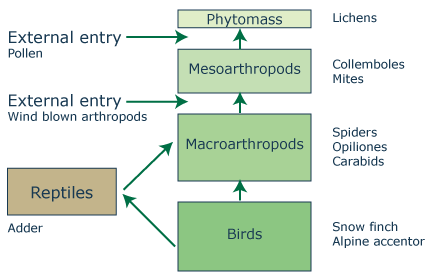 |
|
|
|
|
|
|
Alpine food webs do not principally differ from lowland food webs. Nevertheless, there are some points to consider: |
|
 Explore
the role of species in alpine food webs. Explore
the role of species in alpine food webs. |
1 - Food web of an alpine grassland |
|
Unlike the common food webs of alpine steppes, that do not differ very much from lowland food webs, we can find a more specific food web in the sparse habitats of boulder fields, rocks and snow fields. Phytomass there is very low and food webs are not self-contained. Primary consumers are scarce (due to the lack of plants) and predators depend on external food entry. Nevertheless, a high diversity of predators exists in these areas and their food consists mainly of windblown invertebrates from lower altitudes. |

2 - Food web of an alpine boulderfield |
|
Characteristic for food webs depending on external entry is that they are less predictable and less robust than other food webs. External entry depends on many factors such as wind, weather and season. Food chains within the web are generally short and sometimes incomplete. |
29 August 2011 |
||
| |
||